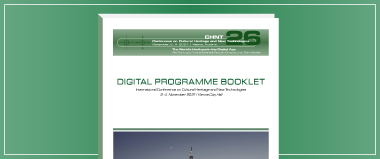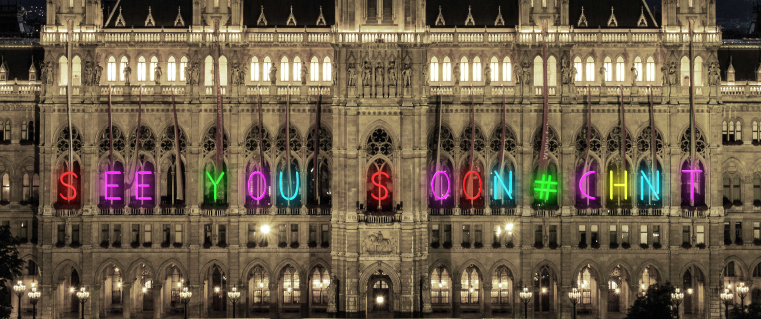Join the online CHNT:
https://hopin.com/events/chnt

Digital Programm Booklet CHNT 26, 2021
Digital Programme Booklet, CHNT26

Latest News
Here you will find the latest information

AUGTRAVELER
Pankaj MANCHNANDA | Sumit GUPTA (Startup in Heritage and Culture Travel Tech Space, Delhi, India) Keyword: AR, World Heritage Sites, COVID ready travel, Community Livelihood, SDGs Augtraveler platform creates enhanced AR, Geo location & Multimedia based curated interpretations for visitors at World Heritage Sites, as well as highlights the Intangible Cultural Heritage of a region, via self-guided geo-location based Cultural Trails. The adoption of this new age technology is even more purposeful in the current times of the pandemic. It provides us an opportunity to “build back better” when visitation begins to increase again. ‘Better’ in the sense of the SDGs for Augtraveler aligns with the direction of SDG Target 11.4. The Augtraveler platform will on board local communities and provide them with an opportunity to highlight (and preserve) their local tangible and intangible cultural heritage via their unique crafts, art, cuisine, music, dance, etc. to tourists and residents alike. Our goal is to promote sustainable tourism to these WHS’s where the local community may receive a major share of tourism dollars through the development and promotion of experiential and immersive travel – by directly connecting them to the visitor economy represented by international and domestic tourists. The platform also provides the community with a curated online marketplace, where they can bring forth and list their local crafts, cuisines, handlooms, theater, art, meditation, heritage walks – as a value-added approach which reflects, extends and builds on the heritage and culture of any region. This mandate aligns with UN SDG 8.9, 12.b An additional spoke is to help younger audiences at schools and help them appreciate India’s rich history and culture in an engaging way. It is our attempt to evolve our monuments from being merely an Instagram photo opportunity, or picnic spot – into knowledge dissemination zones that help to build appreciation and constituencies of support for these Sites. Our vision to evolve this module to broadly align with the intents of SDG Target...
Read MoreVirtual Tourism: From Version 1.0 to 2.0
Bernard FRISCHER (Founder and President, Flyover Zone, USA) Abstract: As a result of the Covid-19 pandemic, the concept of virtual tourism has become more broadly known to the general public, and companies have sprung up to service this new market. To date, the majority of virtual tours have been little more than Powerpoint slide shows enriched by the live commentary of a guide shared over a web service such as Zoom. In this talk, we will discuss the next phase in the evolution of virtual tourism, which we call Virtual Tourism 2.0. This is characterized by three new features as compared to version 1.0: (1) empowerment of the virtual tourist to take active control of the tour, visiting the points of interest in the order dictated by her curiosity; (2) travel through time as well as through space by the use of scientifically created and authenticated 3D reconstructions and restorations; and (3) the possibility to share the virtual tour with a select group of fellow travelers who may be colleagues, friends, or students. In the talk, we will exemplify these features by citing examples from our company’s portfolio of published virtual tours, including, for example, “Baalbek Reborn: Temples,” created in partnership with the German Archaeological Institute and the Lebanese Ministry of Culture. It is available at no cost and runs on devices including mobile (iOS/Android), laptops & PCs (Windows and Mac), and VR headsets (Oculus Rift and HTC Vive). Download it for free at www.flyoverzone.org Virtual tourism 2.0 has advantages not only for end users but also for developers. We have created a Content Management System (CMS) that makes it easy for scientific teams to upload the raw elements of a new tour (images, 3D models, maps, texts, audio, etc.) and to assemble them into a new tour using the Unity game engine. Flyover Zone publishes not only the tours it develops itself with its scientific partners but also the tours of scientists not affiliated with the company, such as many members of the CHNT community who seek a peer-reviewed outlet for their own tours to significant cultural heritage sites. In addition to peer review, the company also offers...
Read MoreTod im Salz
Nicolas SCHIMERL | Pia Patrizia WEBER | Thomas STÖLLNER (Deutsches Bergbau-Museum Bochum, Germany) Keywords: virtual exhibition; Salt Men of Zanjan; Mining Archaeology The web app “Death by Salt. An archaeological investigation in Persia” is a 1:1 copy of the homonymous special exhibition currently on display in the German Mining Museum Bochum. The exhibition’s topic are the so-called ‘Salt Men of Zanjān’. These bodies of eight workers, who died in mining accidents in an Iranian salt mine approximately 1500 and 2500 years ago, were conserved by the salt. They are the only preserved salt mummies worldwide to day. Visitors follow the archaeologists’ research from the initial discovery of the site through excavations and various scientific analysis. This journey ends with the hypothetical reconstruction of one of the workers last day presented in a graphic novel. The digital version of the exhibition is extended by an additional information layer offering users interesting insights such as 3D models of the finds, interviews with researchers, explanatory texts, an audio play for children and a mystery tour that can be played both online and on site in the museum. By using a 3D scan of the analogue exhibition area, users are enabled to navigate freely in the virtual exhibition. Vice versa to bringing the analogue into the digital, digital elements were also integrated in the analogue exhibition in a second connected application. This makes the connection between analogue and digital fluid. Visitors can examine ‘Salt Man 4’ and the mine itself in an AR app. This app offers – like the web app – additional levels of information. The web app additionally features 3D tours through two more exhibitions connected to “Death by Salt”, which are currently on display at the National Museum of Iran and the German Mining Museum. With one application, visitors can visit three exhibitions regardless of time and location. – Statistics about the use of UI elements can be logged for future improvement of the exhibit...
Read More

